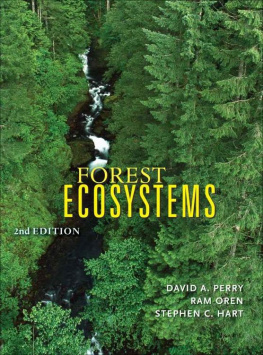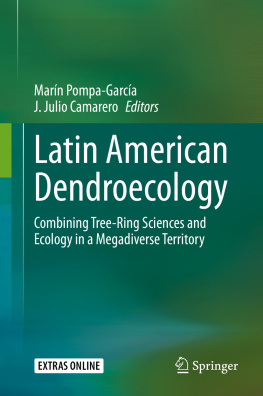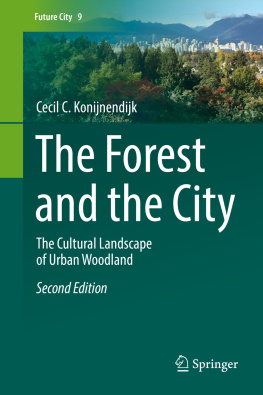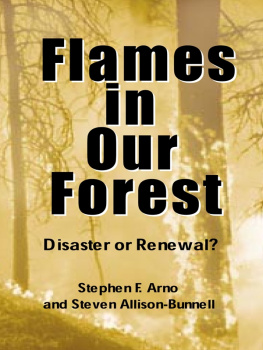FOREST ECOSYSTEMS
FOREST ECOSYSTEMS
Second Edition
DAVID A. PERRY
Department of Forest Science and
Cascade Center for Ecosystems Management
Oregon State University
RAM OREN
Division of Environmental Science and Policy
Nicholas School of the Environment and Earth Sciences
Duke University
STEPHEN C. HART
School of Forestry
Merriam-Powell Center for Environmental Research
Northern Arizona University

2008 The Johns Hopkins University Press
All rights reserved. Published 2008
Printed in the United States of America on acid-free paper
9 8 7 6 5 4 3 2 1
The Johns Hopkins University Press
2715 North Charles Street
Baltimore, Maryland 21218-4363
www.press.jhu.edu
Library of Congress Cataloging-in-Publication Data
Perry, David A.
Forest ecosystems / by David A. Perry, Ram Oren, and Stephen C. Hart2nd ed.
p. cm.
Includes bibliographical references and index.
ISBN-13: 978-0-8018-8840-3 (hardcover : alk. paper)
ISBN-10: 0-8018-8840-9 (hardcover : alk. paper)
1. Forest ecology. I. Oren, Ram, 1952 II. Hart, Stephen C., 1961 III. Title.
QK938.F6P46 2008
577.3dc22 2007042295
A catalog record for this book is available from the British Library.
Special discounts are available for bulk purchases of this book. For more information, please contact Special Sales at 410-516-6936 or specialsales@press.jhu.edu.
The Johns Hopkins University Press uses environmentally friendly book materials, including recycled text paper that is composed of at least 30 percent post-consumer waste, whenever possible. All of our book papers are acid-free, and our jackets and covers are printed on paper with recycled content.
What is needed on our part is the capacity for listening to what the Earth is telling us.
Thomas Berry
Let us bring you songs from the wood
Jethro Tull
CONTENTS
5.3 The Emergent Landscape: Integration of Topography,
Soils, and Disturbance
10.3 Relationships between Forest Structure and the Diversity of
Animals and Microbes
PREFACE TO THE SECOND EDITION
MUCH HAS HAPPENED IN ECOLOGY and forestry since this book first appeared in 1995. In ecology, new concepts of meta-communities and meta-ecosystems have extended and affirmed the importance of spatial interactions in ecological dynamics; a new theory of the forces that create biodiversity has joined an already crowded field; progress has been made on the perennially contentious issue of the relation between biodiversity and stability; the importance of positive interactions in ecosystem dynamics has entered the mainstream; a science of community and ecosystem evolution has emerged; the view of the nitrogen cycle has been revised; long-term data sets have begun to yield information about ecosystem dynamics that play out over decades; new tools have produced insights into aspects of nature ranging from the molecular diversity within ecosystems through the structure of canopies, to the teleconnections that tie the global ecosystem together.
The past decade has been characterized by increasing synthesis of previously separate disciplines, deepening and enriching our understanding of how nature works. By asking questions about what species do in ecosystems, ecologists have initiated the long-overdue coupling of community and ecosystem ecology; the discipline of ecohydrology has emerged to study the interface between hydrology and ecology, and a mega-integrative new discipline, earth system science, has been born from the marriage of the biologic and earth sciences.
Overlaying and permeating all of these developments are three factors in particular: quantification of the crucial role played by forests in providing ecosystem services, allowing values that until recently were not traded in the marketplace to be compared on a more even footing with wood and other readily marketable values; a growing awareness of the earth as a single, highly interactive system (Gaia is real); and climate change, which can no longer be denied and is already manifesting in many ways, including insect outbreaks, fires, and droughts at scales unprecedented in recorded history.
In forestry, sustainability no longer takes a backseat to wood production but has become a central issue, made more so by the unfolding threats of major extinctions, disruptions due to climate change, and extensive forest loss to other land uses. With regard to actually achieving sustainability, we are on the steep part of the learning curve, but on the curve nonetheless. The past few years have seen the formation of the United Nations Forum on Forests, the National Commission on Sustainable Forestry in the United States, a growing network of model forests (born in Canada but spread widely) dedicated to exploring approaches to sustainability, and the publication of key books such as Conserving Forest Biodiversity by Lindenmayer and Franklin, Towards Sustainable Management of the Boreal Forest by a consortium of Canadian scientists, and Designing Sustainable Forest Landscapes by Bell and Apostol. Green certification of forestry operations has grown explosively worldwide. Various criteria and indicators have been developed to provide guidelines. Community forestry, though facing challenges, is including forest-dependent communities as partners in developing sustainable approaches.
There are some things that are given; they have not changed and will not change. One of these is a bedrock principle of ecology that basically says what goes around comes around; in other words, outcomes are determined by interactions, and interactions by outcomes. In forestry, the central unchanging reality is that forests have multiple values for humans, and focusing on one while excluding others leads to both social and biologic problems.
Achieving sustainability is far more than an ecologic and management problem. No workable solution can ignore social, economic, and political factors. It is through our understanding of the workings of nature that we derive workable options and help society understand the consequences of choosing one course over another. With luck, such understanding will lead to wise decisions.
It is impossible to acknowledge all the people who have contributed in one way or another to this book. Everyone we have interacted with over the yearsteachers, students, colleagues, forest managers, members of the environmental community, and private citizens concerned with the stewardship of forestshas helped to shape, test, and refine our knowledge of forest ecosystems. We thank all who have walked in the woods with us, both literally and figuratively.
Families bear much of the brunt of book writingthe long hours, absences, and distracted responses. We are deeply grateful to ours for bearing with us.
Many thanks to Greta Ashworth for bringing her artistry to the figures, Bethany Ross and Linda Forlifer at the Johns Hopkins University Press for greasing skids and overseeing book production, Joanne Bowser and Meg Hanna of Aptara for making the dreaded copyedit process easy, and Jake Kawatski for the indexing.
Finally, a special thanks to Vincent Burke, our acquisitions editor at the Johns Hopkins University Press, for his seemingly bottomless well of patience, support, and good humor.
FOREST ECOSYSTEMS
1
Introduction
Next page








